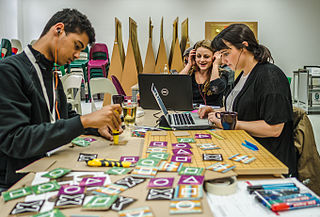
Rendering or image synthesis is the process of generating a photorealistic or non-photorealistic image from a 2D or 3D model by means of a computer program. The resulting image is referred to as the render. Multiple models can be defined in a scene file containing objects in a strictly defined language or data structure. The scene file contains geometry, viewpoint, texture, lighting, and shading information describing the virtual scene. The data contained in the scene file is then passed to a rendering program to be processed and output to a digital image or raster graphics image file. The term "rendering" is analogous to the concept of an artist's impression of a scene. The term "rendering" is also used to describe the process of calculating effects in a video editing program to produce the final video output.

Microsoft DirectX is a collection of application programming interfaces (APIs) for handling tasks related to multimedia, especially game programming and video, on Microsoft platforms. Originally, the names of these APIs all began with "Direct", such as Direct3D, DirectDraw, DirectMusic, DirectPlay, DirectSound, and so forth. The name DirectX was coined as a shorthand term for all of these APIs and soon became the name of the collection. When Microsoft later set out to develop a gaming console, the X was used as the basis of the name Xbox to indicate that the console was based on DirectX technology. The X initial has been carried forward in the naming of APIs designed for the Xbox such as XInput and the Cross-platform Audio Creation Tool (XACT), while the DirectX pattern has been continued for Windows APIs such as Direct2D and DirectWrite.

SIGGRAPH is an annual conference centered around computer graphics organized by ACM, starting in 1974. The main conference is held in North America; SIGGRAPH Asia, a second conference held annually, has been held since 2008 in countries throughout Asia.
Game programming, a subset of game development, is the software development of video games. Game programming requires substantial skill in software engineering and computer programming in a given language, as well as specialization in one or more of the following areas: simulation, computer graphics, artificial intelligence, physics, audio programming, and input. For multiplayer games, knowledge of network programming is required. In some genres, e.g. fighting games, advanced network programming is often demanded, as the netcode and its properties are considered by players and critics to be some of the most important metrics of the game's quality. For massively multiplayer online games (MMOGs), even further knowledge of database programming and advanced networking programming are required. Though often engaged in by professional game programmers, there is a thriving scene of independent developers who lack a relationship with a publishing company.
The Indie Game Jam (IGJ) was an effort to rapidly prototype video game designs and inject new ideas into the game industry. Started in 2002 by a group of game designer-programmers, the event featured a shared game engine technology and worked on by other designer-programmers for a single long weekend. The games resulting from that weekend were then published, open-source, on the IGJ web page.

The Nullarbor demo party is a combined game development and demoscene event in Australia. The event takes place at the beginning of every year in Perth, Western Australia. It was named Nullarbor in reference to Perth's physical isolation from the rest of the Australia. Like other similar demo parties worldwide, it provides a platform for game developers and graphic artists to showcase their skills.

Fluid animation refers to computer graphics techniques for generating realistic animations of fluids such as water and smoke. Fluid animations are typically focused on emulating the qualitative visual behavior of a fluid, with less emphasis placed on rigorously correct physical results, although they often still rely on approximate solutions to the Euler equations or Navier–Stokes equations that govern real fluid physics. Fluid animation can be performed with different levels of complexity, ranging from time-consuming, high-quality animations for films, or visual effects, to simple and fast animations for real-time animations like computer games.

Michael V. Capps or Mike Capps is an American video game designer who was the president of Epic Games, based in Cary, North Carolina from 2002 to 2012. In 2018, he co-founded a new artificial intelligence company called Diveplane Corporation. He has been described as "a legendary figure in the video game industry."

An indie game, short for independent video game, is a video game typically created by individuals or smaller development teams without the financial and technical support of a large game publisher, in contrast to most "AAA" (triple-A) games. Because of their independence and freedom to develop, indie games often focus on innovation, experimental gameplay, and taking risks not usually afforded in AAA games. Indie games tend to be sold through digital distribution channels rather than at retail due to lack of publisher support. The term is synonymous with that of independent music or independent film in those respective mediums.
Spore is a video game developed by Maxis and designed by Will Wright, released in September 2008. The game has drawn wide attention for its ability to simulate the development of a species on a galactic scope, using its innovation of user-guided evolution via the use of procedural generation for many of the components of the game, providing vast scope and open-ended gameplay.

Lindsay Grace is an American academic, artist, and video game designer. He currently serves as the Knight Chair of Interactive Media and is also an Associate Professor at the School of Communication, University of Miami.
George G. Robertson is an American information visualization expert and senior researcher, Visualization and Interaction (VIBE) Research Group, Microsoft Research. With Stuart K. Card, Jock D. Mackinlay and others he invented a number of Information Visualization techniques.

IndieCade is an international juried festival of independent games. Game types include video games, live-action games, and tabletop games. Independent game developers are selected to demo, screen, and promote their work at the annual IndieCade festival and showcase events. IndieCade also includes a conference track featuring classes, panels, workshops, and keynotes. Since 2020, the annual festival has taken place online under the name IndieCade Anywhere & Everywhere.
Miegakure is an in-development puzzle-platform video game by Marc ten Bosch set in a world with four spatial dimensions. Because rendering true four-dimensional (4D) space to a screen is impossible, the game renders two-dimensional images of three-dimensional (3D) slices of its world. Players can change the dimensions used to create the slice and move within the slice, thereby enabling them to move throughout the 4D world. The game has many puzzles that are impossible to solve in a 3D world, but are solvable in the game's 4D world.

Terrence Masson is a computer graphics educator, producer, and lecturer, specializing in animation, storytelling and executive leadership. He is the chair of the MFA Computer Arts Department at the School of Visual Arts (SVA) in New York City. He was also founder and CEO of Building Conversation, an augmented reality company located in Boston, MA. He was both the ACM SIGGRAPH 2006 Computer Animation Festival Chair and 2010 Conference Chair. He also wrote the book CG 101: A Computer Graphics Industry Reference, and has contributed to films, television programs, and video games.

Robin Hunicke is an American video game designer and producer. She is a professor of game design at UC Santa Cruz and the co-founder of Funomena.

A game jam is an event where participants try to make a video game from scratch. Depending on the format, participants might work independently, or in teams. The event duration usually ranges from 24 to 72 hours. Participants are generally programmers, game designers, artists, writers, and others in game development-related fields. While many game jams are run purely as a game-making exercise, some game jams are contests that offer prizes.

In the video game industry, AAA is an informal classification used to categorise video games produced and distributed by a mid-sized or major publisher, which typically have higher development and marketing budgets than other tiers of games. In the mid-2010s, the term "AAA+" was used to describe AAA type games that generated additional revenue over time, in a similar fashion to massively multiplayer online games, by using games-as-a-service methods such as season passes and expansion packs. The similar construction "III" (Triple-I) has also been used to describe high-production-value games in the indie game industry.
Faceware Technologies is a facial animation and motion capture development company in America. The company was established under Image Metrics and became its own company at the beginning of 2012.

AdvertCity is a business simulation video game developed and published by VoxelStorm. The game was released on 17 April 2015 for Microsoft Windows, Linux, OS X. The player takes on the role of an advertising magnate in a dystopian future city with a cyberpunk aesthetic.















